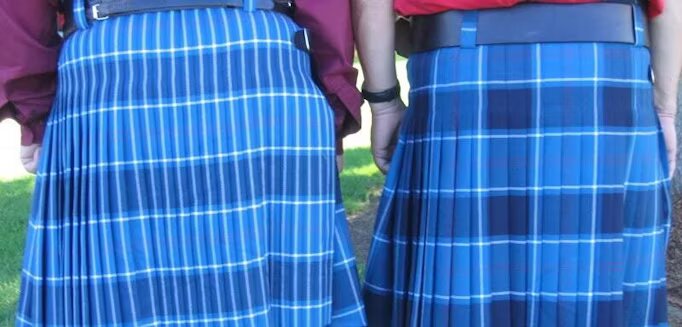
What is the difference between set and stripe kilts?
2 different looks for the back of your kilt.

To Sett:
Pleating your kilt to sett involves folding the pleats, so the pattern aligns seamlessly throughout, matching the tartan sett. This creates a continuous pattern appearance across the kilt, therefore the design should look the same in the front as the back.
To Stripe:
To stripe is to have every pleat identical, with a vertical tartan stripe centered on each pleat. This way the back looks different to the front. This is traditionally the way that military kilts were made, and it was said they were made this way to give a more striking and uniform effect. This method was also more cost-effective, as in some tartans more pleats per meter of fabric can be achieved by pleating "to Stripe".
What Tartan Can I Wear?
7 universal tartans that anyone can wear (including a big surprise!)
Probably the most common question we're asked
What tartan can i wear? We always find a few plaids to wear with pride. But what tartans are there for non-Scots, or if you've no connections with Scotland? Here are in Kilt Home seven ideas for universal tartans that can be worn by everyone. And we'll save the best for last!
Today, some tartans are seen as universal, so anyone can wear these plaids whatever their background. Most famous is Royal Stewart tartan, originally designed for Queen Victoria. Then there's Black Watch tartan, which now commemorates Scotland's most famous regiment. Other examples include MacLeod Dress or 'Loud MacLeod' to its fans. Lindsay, which is so popular it's almost public property. Dress Stewart is much loved for women's wear. And Pride Of Scotland is Scotland's gift to the world. Lastly (wait for it!) there's... almost any tartan on earth. Want to know why?
1. Royal Stewart tartan - where the modern tradition started!
The Royal Stewart Tartan is the best-known plaid on the planet. It was chosen by Sir Walter Scott for King George IV's visit to Edinburgh, when the old laws banning tartan began to be lifted. Commoners soon high jacked the Royal Stewart plaid to show their royalist loyalty. So the royal family later adopted the Balmoral tartan (said to have been designed by Prince Albert) which convention dictates is worn only by them and the Queen's piper!
Nowadays, Royal Stewart is the most widely produced tartan commercially thanks to its striking red color scheme. No one thinks of it as even expressing royalism. It's simply the most widely worn tartan in the world.
2. Black Watch tartan
 The Black Watch Tartan is also known as the Campbell tartan. Dark, moody, and suited to both menswear and womenswear as well as interiors, the subtle depth of Black Watch is what makes it so popular. Even the British Prime Minister (at time of writing) Theresa May often sports a Black Watch suit, cutting a dash while staying on the safe side of sober. No wonder it's so popular.
The Black Watch Tartan is also known as the Campbell tartan. Dark, moody, and suited to both menswear and womenswear as well as interiors, the subtle depth of Black Watch is what makes it so popular. Even the British Prime Minister (at time of writing) Theresa May often sports a Black Watch suit, cutting a dash while staying on the safe side of sober. No wonder it's so popular.
Its common name of Black Watch is because the army adopted this plaid for kilts worns the Argyle & Sutherland Highlanders, or Argyle Regiment or just Argyles for short (now the 3rd Battalion) giving yet another name: Government 1A tartan (though 1B is more commonly woven commercially). This renowned regiment was of course best known as the Black Watch.
3. MacLeod of Lewis tartan

The MacLeod's are found on the Isle of Skye and all over the Inner & Outer Hebrides islands of Scotland, and into the western mainland of Scotland. But MacLeod of Lewis tartan has outgrown these origins to be universally recognized as one of the boldest fabric patterns in the world.
4. Lindsay tartan -
 The Lindsay tartan is another that's been commercially successful thanks to its sophisticated beauty and flexible styling. Popular for everything from school uniforms to ladies' skirts and jackets, the Lindsay tartan has a place in countless hearts.
The Lindsay tartan is another that's been commercially successful thanks to its sophisticated beauty and flexible styling. Popular for everything from school uniforms to ladies' skirts and jackets, the Lindsay tartan has a place in countless hearts.
Descended from Danes, the first Lindsay recorded in Scotland was in 1120 and the family prospered both in both Scotland and England until they had to give up the English parts during the Wars of Scottish Independence. Now the family is found all over the world. But their tartan is found much more widely still!
